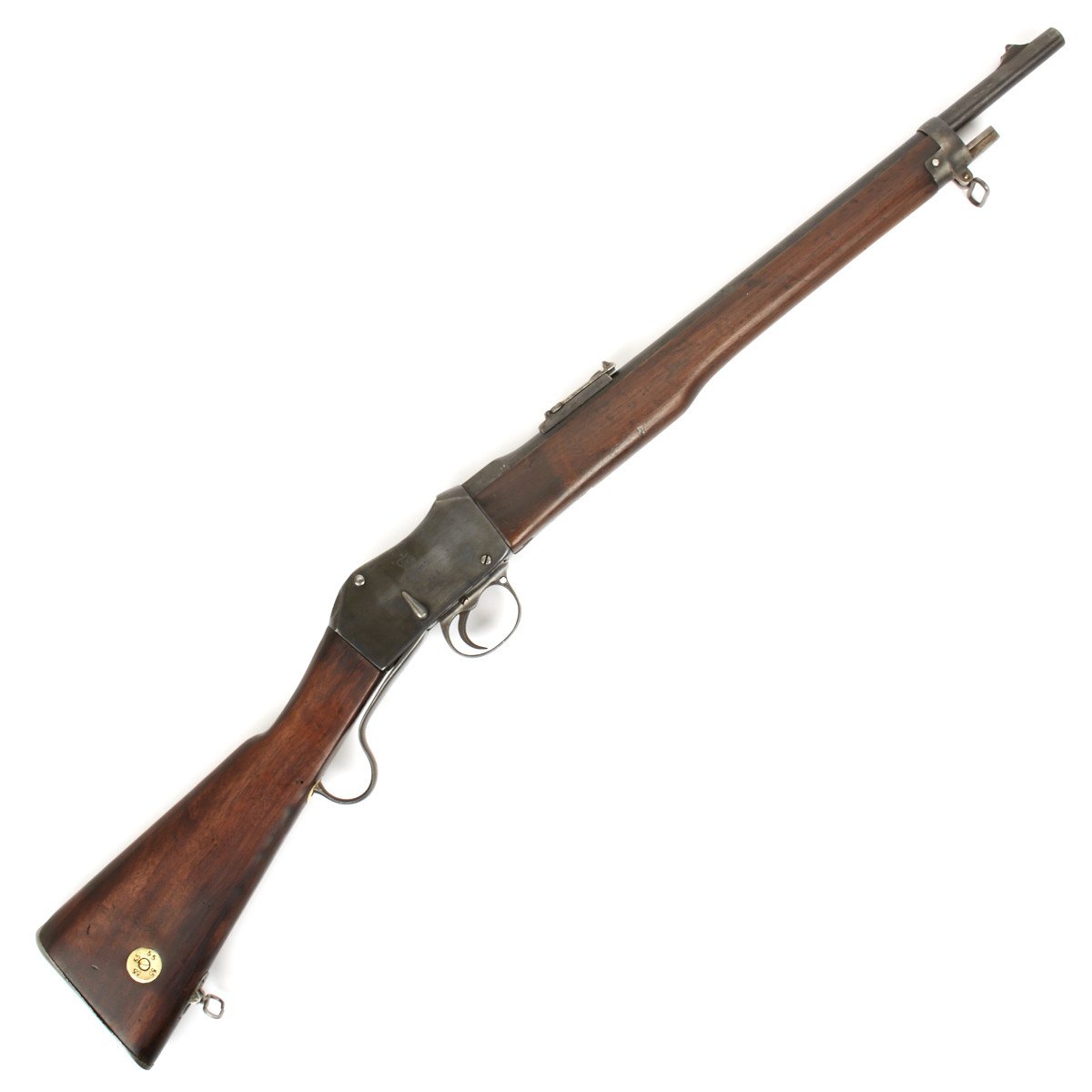Original British Martini-Enfield .303 ACII Artillery Carbine – Dated 1896 Original Items
$ 995,00 $ 248,75
Original Item: Only One Available. The Martini-Enfield Mk I was effectively a Martini-Henry Mk III rebarrelled to .303 and with a new extractor installed, whilst the Martini-Enfield Mk II rifles were generally of new manufacture- although there are examples of converted Mk II rifles.
Originally (from 1889) Martini-Henry conversions used Metford rifled barrels (and were known as Martini-Metford rifles), which were more than suitable for the first .303 cartridges, which used black powder as a propellant, but they wore out very quickly when fired with cordite/nitrocellulose cartridges (introduced in 1895) and so in 1895 the Enfield rifled barrel was introduced, which was much more satisfactory and suitable for use with “modern” (smokeless) ammunition.
The Martini-Enfield was in service from 1895-1918 (Lawrence of Arabia’s Arab Irregulars were known to have used them during the Arab Revolt of 1916-1918, along with any other firearms they could acquire), and it remained a Reserve Arm in places like India and New Zealand until well into World War II.
Martini-Enfield rifles were manufactured/converted by:
– RSAF (Royal Small Arms Factory), Enfield Lock
– LSA Co (London Small Arms Co)
– BSA & M Co (Birmingham Small Arms & Metals Co, later simply BSA)
– HRB Co (Henry Rifle Barrel Co, later went out of business and taken over by Blenheim Engineering)
– NA&A Co (National Arms & Ammunition Co)
Martini-Enfield rifles were very well made and are more than capable of handling modern commercial .303 British ammunition, but as with all second hand firearms, they should always be checked by a competent gunsmith before attempting to fire them.
This example is marked on the action:
V.R.
ENFIELD
1896
ME 303
A,C. II
In very nice condition this model saw service in throughout the British colonies, it is fitted to accept the P-1888 Lee Metford knife bayonet to attach directly under the barrel.
Note- There is some suspicion among our staff that this might be a Khyber pass copy. We completely broken the gun down for cleaning and restoration and it is composed of a majority of British made parts, but there are some in consistencies, such as the lack of proof markings, that make us wonder. Regardless, we have priced it accordingly, and it is still a wonderful look example. However, do not attempt to fire the weapon until having it verified by a certified gunsmith.
Fast Shipping with Professional Packaging
Thanks to our longstanding association with UPS FedEx DHL, and other major international carriers, we are able to provide a range of shipping options. Our warehouse staff is expertly trained and will wrap your products according to our exact and precise specifications. Prior to shipping, your goods will be thoroughly examined and securely secured. We ship to thousands clients each day across multiple countries. This shows how we're dedicated to be the largest retailer on the internet. Warehouses and distribution centres can be located throughout Europe as well as the USA.
Note: Orders with more than one item will be assigned a processing date depending on the item.
Before shipping before shipping, we'll conduct a thorough inspection of the items you have ordered. Today, the majority of orders will be delivered within 48 hours. The delivery time will be between 3-7 days.
Returns
The stock is dynamic and we cannot completely manage it because multiple stakeholders are involved, including our factory and warehouse. So the actual stock may alter at any time. It's possible that you may not receive your order once the order has been made.
Our policy is valid for a period of 30 days. If you don't receive the product within 30 days, we are not able to issue a refund or an exchange.
You can only return an item if it is unused and in the same state as the day you received it. You must have the item in its original packaging.
Related products
Uncategorized
Uncategorized
Uncategorized
Armored Burgonet Helmet & Polearm from Scottish Castle Leith Hall Circa 1700 Original Items
Uncategorized
Uncategorized
Uncategorized
Angolan Rebel 1970s era 60mm Inert Display Mortar from Angolan Civil War Original Items
Uncategorized
Uncategorized
Uncategorized
Band of Brothers ORIGINAL GERMAN WWII Le. F.H. 18 10.5cm ARTILLERY PIECE Original Items
Uncategorized
Uncategorized
Uncategorized
Uncategorized
Uncategorized
Australian WWII Owen MK1 Machine Carbine SMG Custom Fabricated Replica with Sling Original Items
Uncategorized
Uncategorized
Uncategorized













































































